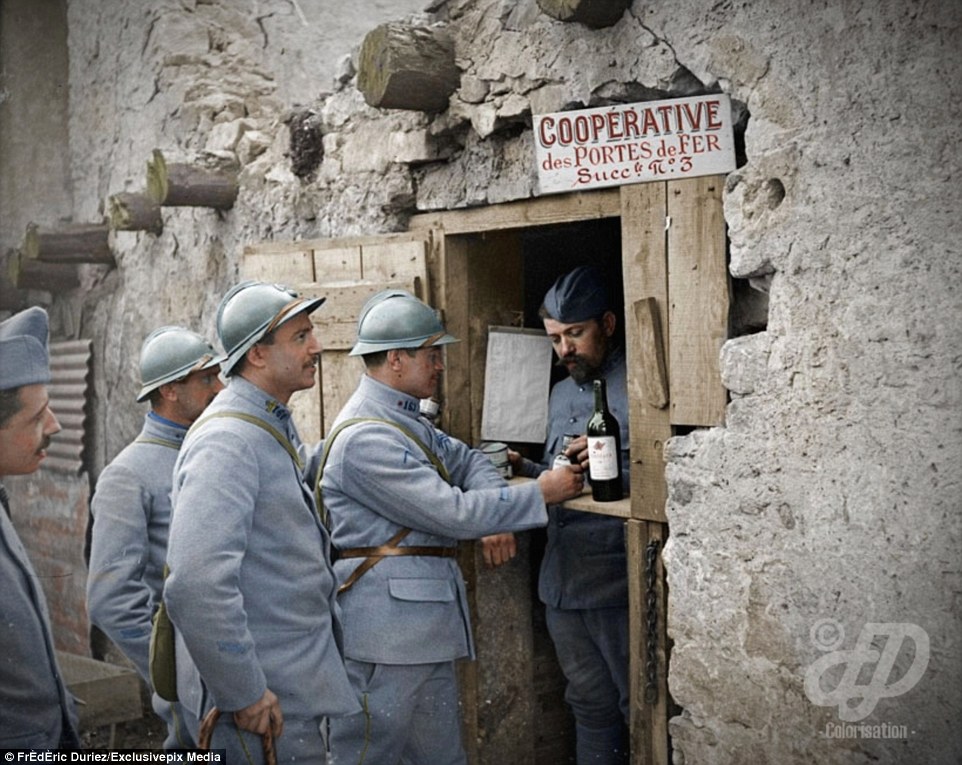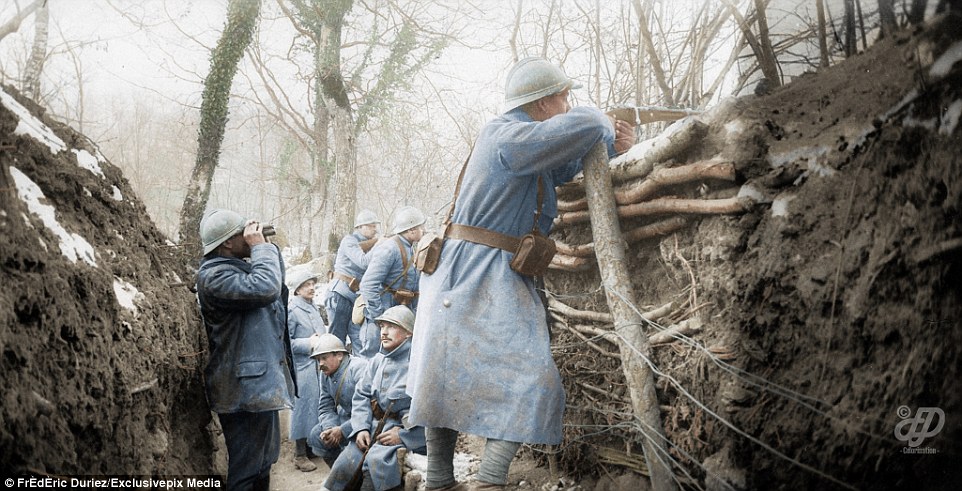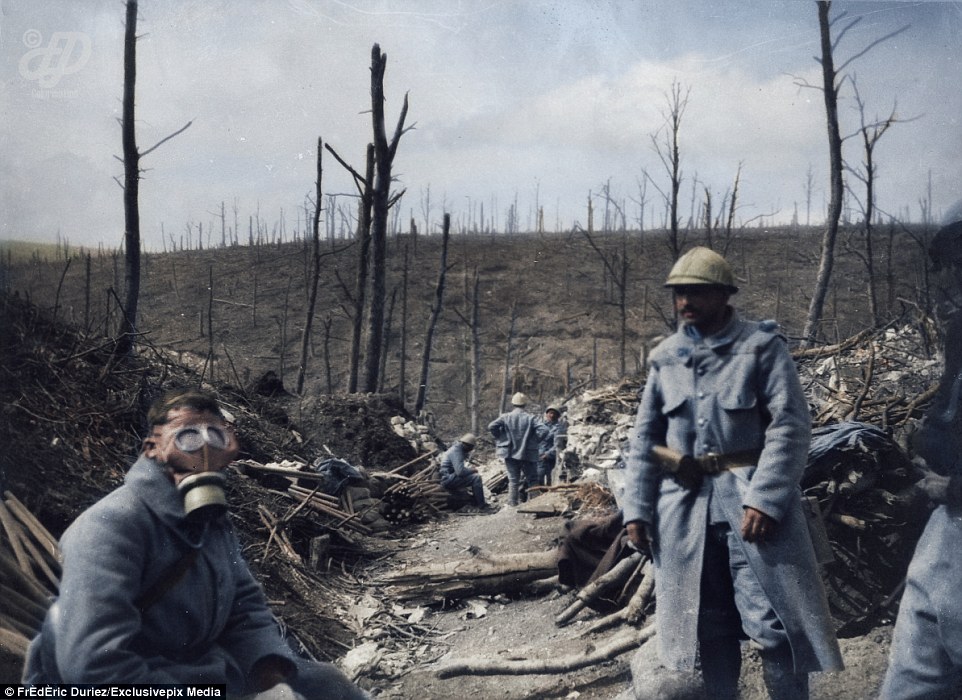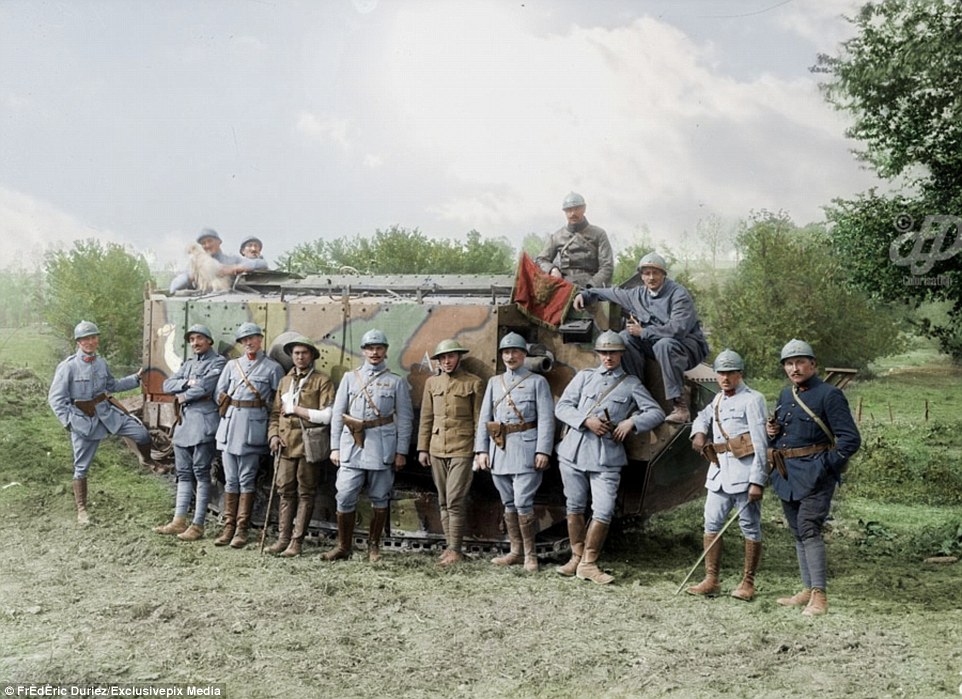- This topic has 1 reply, 1 voice, and was last updated 4 years, 7 months ago by
 Finalsalute.
Finalsalute.
- You must be logged in to reply to this topic.
The horrors of the First World War trenches has been brought to life in a stunning set of colour photographs.
The images colourised by graphic artist Frédéric Duriez reveal the daily lives of beleaguered French soldiers.
They can be seen sharing meals, marching through blitzed towns and carrying bodies across the battlefields.
Some 1.3million French soldiers were killed in the war from 1914 to 1918, while 4.2million more were wounded.
One in 20 people in France lost their lives, with more than half of those mobilised either killed or wounded.
The photographs also reveal the blue-grey uniforms worn by French soldiers, a colour known as ‘horizon blue’.
This colour replaced the infamous red trousers once worn and was said to have blended in with the horizon.
The first year of the war was the bloodiest for the French Army with an average of 2,200 deaths per day.
Some 27,000 died in 1914 at the Battle of Charleroi while the 1915 Artois Offensive had 300,000 casualties.
Click on the pics below for full view
Men from the French 204th Infantry Regiment, 55th Infantry eat soup at Bois des Buttes in September 17, 1917. The area was famous for the Battle of Bois des Buttes in May 1918 which saw the Devonshire Regiment’s heroic actions against the Germans
Men from the French 204th Infantry Regiment, 55th Infantry eat soup at Bois des Buttes in September 17, 1917. The area was famous for the Battle of Bois des Buttes in May 1918 which saw the Devonshire Regiment’s heroic actions against the Germans
 The phrase ‘Cooperative des Portes de Fer’ means ‘Cooperative canteen of the Iron Gates’, which is a reference to the 161th Infantry Regiment surname  of ‘Regiment des Portes de Fer’. This regiment surname was given during the last phase of the Battle of the Somme in October to November 1916. It was the name of a German trench, called Iron Gates trench, in a very strong position in the sector of Rancourt and Sailly-Saillisel – captured by the men of the French 161th Infantry Regiment
The phrase ‘Cooperative des Portes de Fer’ means ‘Cooperative canteen of the Iron Gates’, which is a reference to the 161th Infantry Regiment surname  of ‘Regiment des Portes de Fer’. This regiment surname was given during the last phase of the Battle of the Somme in October to November 1916. It was the name of a German trench, called Iron Gates trench, in a very strong position in the sector of Rancourt and Sailly-Saillisel – captured by the men of the French 161th Infantry Regiment
 French soldiers look out from the Mingasson trench on February 12, 1917, near Bimont Farm, south of the Bois Saint-Mard. One in 20 people in France lost their lives during the war, with more than half of those mobilised either killed or wounded
French soldiers look out from the Mingasson trench on February 12, 1917, near Bimont Farm, south of the Bois Saint-Mard. One in 20 people in France lost their lives during the war, with more than half of those mobilised either killed or wounded
Canadian officers inspect in a large French gun mounted on a railroad in October 1917, in one of a series of startling images from the First World War which have been brought to life after being colourised by graphic artist Frédéric Duriez
The phrase ‘Cooperative des Portes de Fer’ means ‘Cooperative canteen of the Iron Gates’, which is a reference to the 161th Infantry Regiment surname  of ‘Regiment des Portes de Fer’. This regiment surname was given during the last phase of the Battle of the Somme in October to November 1916. It was the name of a German trench, called Iron Gates trench, in a very strong position in the sector of Rancourt and Sailly-Saillisel – captured by the men of the French 161th Infantry Regiment
French soldiers eat soup at a police station in Neuvilly on December 7, 1915. Their blue-grey uniforms – in a colour known as ‘horizon blue’ – are dirty after a period of six days of incessant rains which had overwhelmed their trenches
French troops returning from Fort de Vaux in Vaux-Devant-Damloup, Meuse, to the area of Nixèville on April 8, 1916, in one of a stunning series of colourised photographs that capture life as a soldier during the First World War of 1914 to 1918
After fighting during the Battle of Verdun in 1916, soldiers surrounded the bodies of their comrades. Verdun was the longest battle of the First World War, lasting 300 days and leaving an estimated 800,000 soldiers dead, wounded or missing
Stretcher bearers take dead soldiers for burial on the battlefield near a farm in La Bourdonnerie, south of Chavenay in Marne on July 14, 1918. Some 1.3million French soldiers were killed during the First World War from 1914 to 1918
 A French soldier tries on a German gas mask found on the ground at ‘Wood of the Caillette’ in 1916. The photographs reveal the blue-grey uniforms worn by French soldiers, a colour known as ‘horizon blue’. This replaced the infamous red trousers
A French soldier tries on a German gas mask found on the ground at ‘Wood of the Caillette’ in 1916. The photographs reveal the blue-grey uniforms worn by French soldiers, a colour known as ‘horizon blue’. This replaced the infamous red trousers
French and British soldiers stand around a German A7V tank captured at Villers-Brettoneux in May 1918. The French artillery fired more than 330,000,000 shells during the First World War, which is more than 210,000 rounds each day
A French soldier lies dead after being killed while he ate at Bois de Spandau in north-east Bois Sabot on October 27, 1915. In the same year between May 9 and June 18, the Artois Offensive cost 300,000 French lives and wounded men
A French trench at Bois St Eloi in the Somme on October 28, 1916. In the background, German accessory defences are seen. More than a third of French soldiers (36 per cent) aged between 19 and 22 were killed during the First World War
French Senegalese troops get acquainted with their new gas masks. Gas masks were made and used during the First World War because of poison gas attacks that surprised the Allies in the trenches on the Western Front
Soldiers from 28th Regiment stand in a trench at the Somme. The Battle between July and November 1916 symbolised the horrors of First World War warfare. The French lost 200,000 men while the British suffered 420,000 casualties
Soldiers from 28th Regiment stand in a trench at the Somme. The Battle between July and November 1916 symbolised the horrors of First World War warfare. The French lost 200,000 men while the British suffered 420,000 casualties
 French and American officers who took part in the reconquest of Cantigny stand in front of a Schneider French tank in May 1918. The armoured fighting vehicle is still viewed today as the first French tank, even though it was not turreted
French and American officers who took part in the reconquest of Cantigny stand in front of a Schneider French tank in May 1918. The armoured fighting vehicle is still viewed today as the first French tank, even though it was not turreted
French lines on the right bank of the Seille being held by the 150th Infantry Regiment, 5th Battalion in Port-sur-Seille, Meurthe-et-Moselle, in March 1918, in one of many First World War images colourised by graphic artist Frédéric Duriez
Source: http://www.dailymail.co.uk/